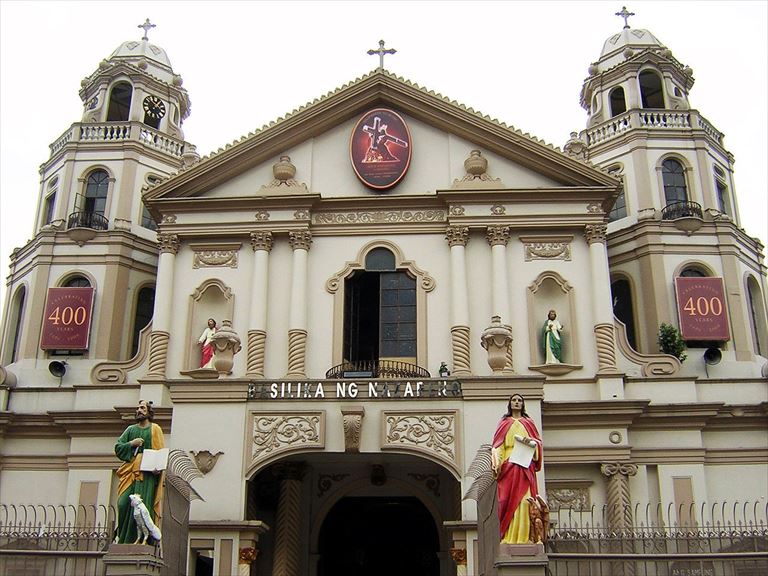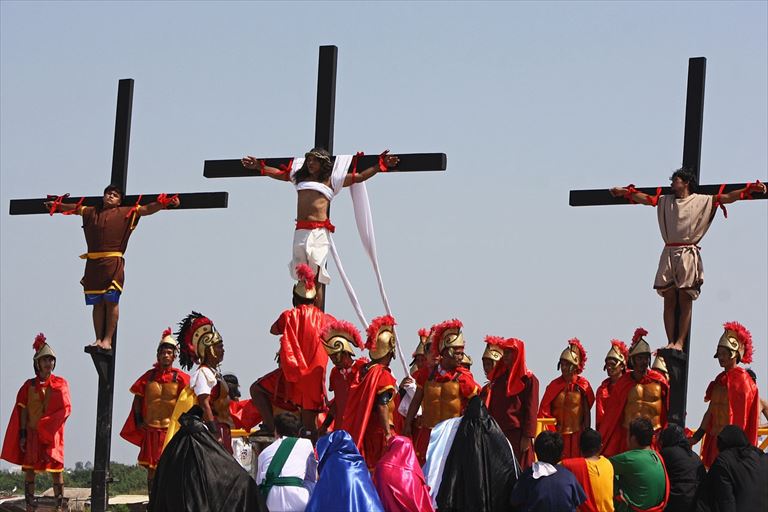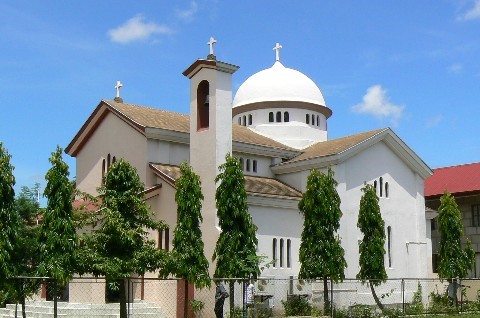Faith, derived from Latin fides and Old French feid, is confidence or trust in a person, thing, or concept. In the context of religion, one can define faith as “belief in God or in the doctrines or teachings of religion”. Religious people often think of faith as confidence based on a perceived degree of warrant, while others who are more skeptical of religion tend to think of faith as simply belief without evidence.
Different religions may or may not contain various elements ranging from the divine, sacred things, faith, a supernatural being or supernatural beings or “some sort of ultimacy and transcendence that will provide norms and power for the rest of life”. Religious practices may include rituals, sermons, commemoration or veneration (of deities and/or saints), sacrifices, festivals, feasts, trances, initiations, funerary services, matrimonial services, meditation, prayer, music, art, dance, public service, or other aspects of human culture. Religions have sacred histories and narratives, which may be preserved in sacred scriptures, and symbols and holy places, that aim mostly to give a meaning to life. Religions may contain symbolic stories, which are sometimes said by followers to be true, that have the side purpose of explaining the origin of life, the universe, and other things. Traditionally, faith, in addition to reason, has been considered a source of religious beliefs.
As a person who grows up in the Philippines, I know that majority of the people should belong in a congregation. Every sunday morning Filipino families will prepare themselves to go to church and after the mass or worship service it’s either they will go home to have a family get together or spend some time together outside. Being in a religious family have some pros and cons, but I’m absolutely fine with my conservative family. Our grandparents are the ones who influences us to be religious and they are the one who taught us to always have faith in God, to always pray before we eat, before we sleep and devout ourseleves in religious activities. I found religion good for socializations. Meeting people with the same faith and not be judged for your beliefs, and having a friend which belongs to the same church is great.
Religion in the Philippines is marked by a majority of people being adherents of the Christian faith. At least 92% of the population is Christian; about 81% belong to the Catholic Church while about 11% belong to Protestantism, Orthodoxy, Restorationist and Independent Catholicism and other denominations such as Iglesia Filipina Independiente, Iglesia ni Cristo, Seventh-day Adventist Church, United Church of Christ in the Philippines, Members Church of God International (MCGI) and Evangelicals. Officially, the Philippines is a secular nation, with the Constitution guaranteeing separation of church and state, and requiring the government to respect all religious beliefs equally.
Here are some of the most popular religions in the Philippines.
Roman Catholic

Quiapo Church
The Catholic Church in the Philippines is part of the worldwide Catholic Church, under the spiritual direction of the Pope. The Philippines is one of the two nations in Asia having a substantial portion of the population professing the Catholic faith, along with East Timor, and has the third largest Catholic population in the world after Brazil and Mexico. The episcopal conference responsible in governing the faith is the Catholic Bishops’ Conference of the Philippines.
Christianity was first brought to the Philippine islands by Spanish missionaries and settlers, who arrived in waves beginning in the early 16th century in Cebu. Compared to the Spanish Era, when Christianity was recognized as the state religion, the faith today is practiced in the context of a secular state. In 2015, it was estimated that 84 million Filipinos, or roughly 82.9% to 85% of the population, profess the Catholic faith.
Catholic holy days, such as Christmas and Good Friday, are observed as national holidays, with local saints’ days being observed as holidays in different towns and cities. The Hispanic-influenced custom of holding fiestas in honour of patron saints have become an integral part of Filipino culture, as it allows for communal celebration while serving as a time marker for the year. Holy Week is when many people perform holy rites in fulfillment of a vow they made when they asked God a favor, such as a cure for an illness. Priests and religious statues are dressed in purple to symbolize gloom. Devout Catholics go to church everyday; some fast.
The most striking feature of Holy Week celebrations in the Philippines is the sight of Filipinos publicly whipping themselves. These are reenactments of the torture and death of Jesus. Some Filipinos not only whip their backs into a bloody mess — they also have their feet and hands nailed to a wooden cross. Tourists come from all over the world for the sight! In Manila, Tondo is the place to see these flagellants. Outside the capital, Pampanga and Nueva Ecija are famous for their flagellants who cover their faces with white cotton hoods. Crowns of thorns are placed on their heads to cause blood to drip.
Crucifixion in the Philippines is a devotional practice held every Good Friday, and is part of the local observance of Holy Week. Devotees or penitents called magdarame in Kapampangan are willingly crucified in imitation of Jesus Christ’s suffering and death, while related practices include carrying wooden crosses, crawling on rough pavement, and self-flagellation. Penitents consider these acts to be mortification of the flesh, and undertake these to ask forgiveness for sins, to fulfil a panatà (Filipino, “vow”), or to express gratitude for favours granted. In the most famous case, Ruben Enaje drives four-inch nails into both hands and feet and then he is lifted on a wooden cross for around five minutes.

Filipino Catholic practice is unusually material and physical, even among Catholic cultures, built especially on devotions to Mary, the suffering Christ, and the Santo Niño (Holy Child), and on powerful celebratory and penitential rituals practiced and experienced in a wide variety of Filipino vernacular forms. Feasts like the Black Nazarene, which draws millions to the streets of Manila in January, the Simbang Gabi novena that precedes Christmas, and the month-long Flores de Mayo offering to Mary illustrate distinctively Filipino forms of devotion.
Philippine Independent Church

Cathedral of St. William
The Philippine Independent Church (Spanish: Iglesia Filipina Independiente; Tagalog: Malayang Simbahan ng Pilipinas; Latin: Libera Ecclesia Philippina; colloquially called the Aglipayan Church, IFI and PIC) is an independent Christian denomination in the form of a national church in the Philippines. Its schism from the Roman Catholic Church was proclaimed in 1902 by the members of the Unión Obrera Democrática Filipina, due to the mistreatment of the Filipinos by Spanish priests and the execution of José Rizal during Spanish colonial rule.
Isabelo de los Reyes was one of the initiators of the separation, and suggested that former Catholic priest Gregorio Aglipay be the head of the church. It is also known as the “Aglipayan Church”, after its first Supreme Bishop, Gregorio Aglipay, who like José Rizal, later became a Freemason, in May 1918.
Pope Leo XIII instructed the Archbishop of Manila, Bernardino Nozaleda y Villa to excommunicate those who initiated the schism. Since 1960 the church has been in full communion with the Episcopal Church in the United States, and through it, the entire Anglican Communion.
Members commonly believe in the rejection of the exclusivity right to apostolic succession by the Petrine papacy, the allowing of priestly ordination of women, optional clerical celibacy, tolerance of Freemasonry, and support for contraception and same-sex civil rights, however the members of the Church still believe in transubstantiation and the Real presence of Christ in the Eucharist. Many saints canonized by Rome after the 1902 schism are not recognized by the Aglipayan church and its members.
Iglesia ni Cristo

NC Central Temple in Quezon City
Iglesia ni Cristo, abbreviated as INC is an independent nontrinitarian Christian church, founded and registered by Felix Y. Manalo in 1914 as a unipersonal religious corporation to the United States administration of the Philippines.
INC describes itself to be the one true church and the restoration of the original church founded by Jesus, whereby all other Christian churches are apostate. According to INC doctrine, the official registration of the church with the Philippine government on July 27, 1914, by Felix Y. Manalo—who is upheld by members to be the last messenger of God—was an act of divine providence and the fulfillment of biblical prophecy concerning the re-establishment of the original church of Christ in the Far East concurrent with the coming of the seventh seal marking the end of days.
By the time of Manalo’s death in 1963, INC had become a nationwide church with 1,250 local chapels and 35 large concrete cathedrals. As his successor, Manalo’s son, Eraño G. Manalo, led a campaign to grow and internationalize the church until his death on August 31, 2009, whereupon his son, Eduardo V. Manalo, likewise succeeded him as Executive Minister. In 2015, the Philippine census by the Philippine Statistics Authority found that 2.64% of the population in the Philippines are affiliated with the Iglesia Ni Cristo, making it the religion with the third largest number of adherents, with Islam at 6.01% and Catholicism at 79.53%
Jesus Miracle Crusade
The Jesus Miracle Crusade International Ministry (JMCIM) is an Apostolic (Oneness) Pentecostal religious group in the Philippines which believes particularly in the promotion of miracles, and faith in God for healing. They currently claim 1,500,000 members in the Philippines and 15 other countries. With 40 assemblies outside the Philippines, the bulk of their membership is within the country. It has members in the Philippines, the United States, Canada, Europe, the Middle East, Australia, Singapore, Japan, China, and several parts of Asia. JMCIM is the largest Oneness Pentecostal organization in the Philippines, holding several services weekly at the Amoranto Sports Complex in Quezon City, Metro Manila, with Sunday attendance in the tens of thousands at that location alone. Their 40th Anniversary celebration in 2015 saw 300,000 people gather at the Cultural Center of the Philippines in Pasay City, Metro Manila.
JMCIM is a highly structured organization with Almeda as its Dearly Beloved Honorable Evangelist-Pastor. He remains their only pastor. All other ministers have the title of Beloved Ministers or Beloved Preachers and work entirely under the governing authority of the church. Their members are referred to as Beloved Brethren. Almeda’s wife, now deceased, is called Beloved Assistant Pastor Lina C. Almeda. The organization published a 252-page bilingual (English-Tagalog) Preacher’s Handbook in 2011 that offers standard instructions for all ministers or preachers covering subjects including doctrines and how to conduct services for weddings, child dedications and so forth.
Philippine Orthodox Church

The Annunciation Orthodox Cathedral
Armenians and Greeks are recorded to have been the first Orthodox Christians on Luzon. An eighteenth century document written by Pedro Murillo Velarde, a Jesuit historian describing their order’s missionary labors in the Philippines, records the presence of such settlers in Manila as early as 1618.
Around the beginning of the 20th century, Greek sailors settled in Legazpi, Albay on the island of Luzon. Their descendants now number no more than 10 families, who have kept their Greek family names and have become distinguished public figures and intellectuals, including serving in the Greek consulate in Manila. One of the first Orthodox Christian faithful to arrive in the province of Albay was Aléxandros Áthōs Adamópoulos (later anglicized to Alexander A. Adamson), who came to Legaspi City in 1928. Together with his brother and cousin he co-founded Adamson University in 1932, which is now owned by the Vincentian Fathers of the Roman Catholic Church.
In 1989, Adamopoulos saw the need to establish the first Greek Orthodox church in the Philippines and thus established the Hellenic Orthodox Foundation, Inc., but he died in 1993 before the church was completed. The Annunciation Orthodox Cathedral in Sucat, Parañaque City, Metro Manila, was finished in 1996 and was consecrated by Ecumenical Patriarch Bartholomew I of Constantinople in 2000.
Since then, other autocephalous Orthodox churches have established their presence in the Philippines.
Protestantism in the Philippines

Jaro Evangelical Church
Protestant denominations arrived in the Philippines in 1898, after the United States took control of the Philippines from Spain, first with the United States Army as chaplains and then within months the denominations sent missionaries.
Protestants makes up nearly 11% of the Filipino population. They include a wide variety of Pentecostal, Evangelical and independent churches. Some denominations were founded locally by indigenous people.
Protestant missionaries founded many schools and universities in the Philippines. Some of which are founded by early American Protestant missionaries. Most notable of these is Silliman University, the first Protestant school in the country and the first university founded by Americans in Asia. Silliman is followed by the Central Philippine University, its sister institution, and other institutions of higher learning such as Trinity University of Asia, West Negros University, Filamer Christian University, the Philippine Christian University and the Adventist University of the Philippines.
I think religious teachings stress the requirement for serving our individual man. The loftiest instructing is to do this sacrificial assistance without desire for remuneration or applause however to work with a sentiment of unity and recognizable proof with others. In its most flawless structure, religion can rouse individuals to serve the government assistance of others, not out of conscience, yet out of a feeling of awesome obligation. This rule of caring assistance is found in all the principle religions and has prompted the establishment of numerous altruistic works. Religion can be a main focus of the community. It can unite individuals as they share basic yearnings to have a superior existence. A congregation, mosque or place of worship can be the focal point of network life and give an outlet to individuals to discover fellowship and presence of mind of direction. I think religion is more likely to cultivate a sense of community rather than just individuality.
https://en.wikipedia.org/wiki/Faith
https://en.wikipedia.org/wiki/Religion_in_the_Philippines
https://en.wikipedia.org/wiki/Philippine_Independent_Church
https://en.wikipedia.org/wiki/Jesus_Miracle_Crusade
https://en.wikipedia.org/wiki/Protestants_in_the_Philippines
https://en.wikipedia.org/wiki/Crucifixion_in_the_Philippines